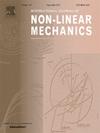Physics-based modeling of the temperature-dependent fatigue behavior of natural and synthetic polyisoprene rubbers
IF 3.2
3区 工程技术
Q2 MECHANICS
International Journal of Non-Linear Mechanics
Pub Date : 2025-05-23
DOI:10.1016/j.ijnonlinmec.2025.105171
引用次数: 0
Abstract
The mechanical properties of rubbers are typically highly sensitive to temperature, and fatigue crack initiation resistance is no exception. Despite abundant documentation in the scientific literature, the mechanisms driving this temperature dependence remain insufficiently understood. A common approach to addressing this phenomenon is the time-temperature equivalence method. Although it offers reasonably accurate results, it lacks predictive power due to its empirical nature.
This article introduces a novel predictive model for the S–N curves of rubbers with respect to temperature, grounded in the Work-Heat Equivalence Principle. This innovative framework is built on a robust physical foundation, with its predictive accuracy enhanced by the absence of fitting parameters. The model's performance is evaluated using an extensive dataset, including newly acquired experimental data, literature-derived results from temperature-controlled fatigue tests on isoprene rubber (IR), and insights from fatigue tests performed on thick rubber parts accompanied by self-heating-induced temperature rises reported in previous studies.
The good correlation between the model's predictions and experimental observations underscores the significant role of the proposed mechanism in governing the temperature dependency of rubber fatigue life.
天然和合成聚异戊二烯橡胶温度依赖性疲劳行为的物理建模
橡胶的力学性能通常对温度高度敏感,抗疲劳起裂性能也不例外。尽管在科学文献中有大量的记录,但驱动这种温度依赖性的机制仍然没有得到充分的了解。解决这一现象的常用方法是时间-温度等效法。虽然它提供了相当准确的结果,但由于其经验性质,它缺乏预测能力。本文以工热等效原理为基础,提出了一种新的橡胶S-N曲线随温度变化的预测模型。这种创新的框架建立在强大的物理基础上,由于没有拟合参数,其预测精度得到了提高。该模型的性能使用广泛的数据集进行评估,包括新获得的实验数据,来自异戊二烯橡胶(IR)温度控制疲劳测试的文献结果,以及来自厚橡胶部件的疲劳测试的见解,伴随着先前研究报告的自热诱导温度升高。模型预测和实验观察之间的良好相关性强调了所提出的机制在控制橡胶疲劳寿命的温度依赖性方面的重要作用。
本文章由计算机程序翻译,如有差异,请以英文原文为准。
求助全文
约1分钟内获得全文
求助全文
来源期刊
CiteScore
5.50
自引率
9.40%
发文量
192
审稿时长
67 days
期刊介绍:
The International Journal of Non-Linear Mechanics provides a specific medium for dissemination of high-quality research results in the various areas of theoretical, applied, and experimental mechanics of solids, fluids, structures, and systems where the phenomena are inherently non-linear.
The journal brings together original results in non-linear problems in elasticity, plasticity, dynamics, vibrations, wave-propagation, rheology, fluid-structure interaction systems, stability, biomechanics, micro- and nano-structures, materials, metamaterials, and in other diverse areas.
Papers may be analytical, computational or experimental in nature. Treatments of non-linear differential equations wherein solutions and properties of solutions are emphasized but physical aspects are not adequately relevant, will not be considered for possible publication. Both deterministic and stochastic approaches are fostered. Contributions pertaining to both established and emerging fields are encouraged.

 求助内容:
求助内容: 应助结果提醒方式:
应助结果提醒方式:


